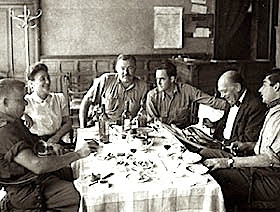The 'unidentified Signal Corps photographer' is almost certainly Ivan Moffat a British screenwriter, film producer and socialite. His account of his time with Hemingway appears in The Ivan Moffat File: Life Among the Beautiful and Damned in London, Paris, New York,and Hollywood (Gavin Lambert 2004). He was the son of beautiful Bloomsbury figure Iris Tree several of whose letters we have and will post. During World War II, he filmed activities of the U.S. Army for the Signal Corps and after the war worked at Paramount Pictures. In the 1950s, between his two marriages, Moffat had a series of love affairs, notably with Elizabeth Taylor and Lady Caroline Blackwood who later married Lucian Freud. He wrote or co-wrote screenplays for a number of well-known films, including Giant and later the TV series Colditz. He appears to have been fairly unfazed by the Hemingway mythos. Mont St Michel still serves good omelettes, but is the tile initialled by Hemingway still on the roof of the church?
Ernest Hemingway joined our unit at Mont St. Michel, a small cluster of houses below a tall medieval church, perched on a small rocky island near the border of Normandy and Brittany. Irwin [Shaw] had taken me to meet Hemingway in his suite at the Dorchester Hotel in London, where he had shown off his collection of shotguns and rifles, pre-invasion rows of boots, and a portable canvas device that would enable him to cross rivers.
I had wondered why he needed all that stuff as a war reporter for Colliers, but was either too awed or too polite to ask. A few weeks later I had met Hemingway again at the beachhead. He wore a Wehrmacht belt and told me, "I got it off a dead Kraut." This time I wondered, again without asking, why he bothered to explain.
At Mont St. Michel a woman ran out from an inn to greet Hemingway, and he lifted her up in his arms as she laughed and kissed him and called him Papa. Then, at the inn, he toasted Irwin and Stevens with wine and Calvados, and we ate delicious omelettes, the first good meal any of our outfit had tasted since London.
As it grew dark, brilliant artillery flashes lit up the sky, not very far away toward the east. They grew even more dazzling as the sound of gunfire grew louder. An American colonel joined us and said there was a heavy German counterattack from Mortaing, aimed at splitting our army in two. By then we were all a bit high, and enjoying a sense of vicarious participation in an event that was exciting but not in the least threatening.
In the morning Hemingway and I climbed the steep narrow steps to the church, then up to the church roof, where we scraped our initials on one of the slate tiles, and Hemingway grinned like a kid.

